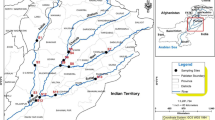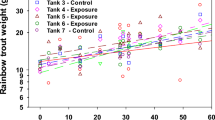Abstract
Existing regulatory criteria for bioaccumulation assessment of chemicals are mainly based on a bioconcentration factors (BCF) not a biomagnification factors (BMF). We performed dietary exposure tests for nine poorly water-soluble chemicals and developed a linear regression between the 5 % lipid normalized BCF (BCFL) and the lipid-corrected BMF (BMFL). The BMFL of substances with BCFL = 5,000 was 0.31 (95 % CI 0.11–0.87), whereas the BCFL of substances with BMFL = 1 was 13,000 (95 % CI 5,600–30,000). Five substances can be considered very bioaccumulative (vB) according to the BCF end point (BCF > 5,000), but only two substances were recognized to biomagnify according to the BMF end point (BMF ≥ 1). Although our results are highly suggestive of a relationship between BCF and BMF, additional BMF and trophic magnification factor data for chemicals are required to support this relationship, and new techniques (e.g., fugacity approach) may help in resolving the apparent contradiction in hazard categorization.



Similar content being viewed by others
References
Anonymous (2004a) Fish, dietary bioaccumulation study–Basic protocol, 20 Jan 2004. Document 071121_Chapter_R.11_Final.doc submitted to the Technical Committee for New and Existing Substances Working Group (TC-NES) by the Persistent Bioaccumulative and Toxic (PBT) working group
Anonymous (2004b) Fish, dietary bioaccumulation study–Background document to the fish dietary study protocol, 20 Jan 2004. Document 071121_Chapter_R.11_Final.doc submitted to TC-NES by the PBT working group
Arnot JA, Gobas FAPC (2006) A review of bioconcentration factor (BCF) and bioaccumulation factor (BAF) assessments for organic chemicals in fish. Environ Rev 14:257–297
Bertelsen SL, Hoffman AD, Gallinat CA, Elonen CM, Nichols JW (1998) Evaluation of log Kow and tissue lipid content as predictors of chemical partitioning to fish tissues. Environ Toxicol Chem 17:1447–1455
Bligh EG, Dyer WJ (1959) A rapid method of total lipid extraction and purification. Can J Biochem Physiol 37:911–917
Burkhard LP, Arnot JA, Embry MR, Farley KJ, Hoke RA, Kitano M et al (2012) Comparing laboratory and field measured bioaccumulation endpoints. Integr Environ Assess Manag 8:17–31
Dimitrov S, Dimitrova N, Parkerton T, Comber M, Bonneil M, Mekenyan O (2005) Base-line model for identifying the bioaccumulation potential of chemicals. SAR QSAR Environ Res 16:531–554
Fu WJ, Franco A, Trapp S (2009) Methods for estimating the bioconcentration factor of ionizable organic chemicals. Environ Toxicol Chem 28:1372–1379
Gobas FAPC, Wilcockson JB, Russell RW, Haffner GD (1999) Mechanism of biomagnification in fish under laboratory and field conditions. Environ Sci Technol 33:133–141
Gobas FAPC, de Wolf W, Burkhard LP, Verbruggen E, Plotzke E (2009) Revisiting bioaccumulation criteria for POPs and PBT assessments. Integr Environ Assess Manag 5(4):624–637
Inoue Y, Hashizume N, Kikushima E, Otsuka M (2011) Comparison of nitrofen uptake via water and food and its distribution in tissue of common carp, Cyprinus carpio L. Bull Environ Contam Toxicol 87:287–291
Kitano M (2007) Discussion paper on bioaccumulation evaluation. Geneva (CH). UNEP/POPS/POPRC.3/INF/8
Klecka GM, Muir DCG, Dohmen P, Eisenreigh SJ, Gobas FAPC, Jones K et al (2009) Introduction to special series: science-based guidance and framework for the evaluation and identification of PBTs and POPs. Integr Environ Assess Manag 4:535–538
Ku HH (1966) Notes on the use of propagation of error formulas. J Res Natl Bur Stand 70C:263–273
Newman MC (2009) Fundamentals of ecotoxicology, 3rd edn. CRC Press Taylor & Francis Group, Boca Raton
Organization for Economic Co-operation and Development (1996) OECD guidelines for testing of chemicals. Guideline 305. Bioconcentration: Flow-through fish test. OECD, Paris
Qiao P, Gobas FAPC, Farrell AP (2000) Relative contributions of aqueous and dietary uptake of hydrophobic chemicals to the body burden in juvenile rainbow trout. Arch Environ Contam Toxicol 39:369–377
Randall DJ, Connell DW, Yang R, Wu SS (1988) Concentrations of persistent lipophilic compounds in fish are determined by exchange across the gills, not through the food chain. Chemosphere 37:1263–1270
Thomann RV (1989) Bioaccumulation model of organic chemical distribution in aquatic food chains. Environ Sci Technol 23:699–707
Tietge JE, Johnson RD, Jensen KM, Cook PM, Elonen GE, Fernandez JD et al (1998) Reproductive toxicity and disposition of 2,3,7,8-tetrachlorodibenzo-p-dioxin in adult brook trout (Salvelinus fontinalis) following a dietary exposure. Environ Toxicol Chem 17:2395–2407
Yang R, Brauner C, Thurston V, Neuman J, Randall DJ (2000) Relationship between toxicant transfer kinetic processes and fish oxygen consumption. Aquat Toxicol 48:95–108
Acknowledgments
This study was commissioned in part by the Ministry of Economy, Trade and Industry of Japan. We are grateful to our fish care experts, Y. Kawashima and T. Ishibashi (CERI Kurume).
Author information
Authors and Affiliations
Corresponding author
Rights and permissions
About this article
Cite this article
Inoue, Y., Hashizume, N., Yoshida, T. et al. Comparison of Bioconcentration and Biomagnification Factors for Poorly Water-Soluble Chemicals Using Common Carp (Cyprinus carpio L.). Arch Environ Contam Toxicol 63, 241–248 (2012). https://doi.org/10.1007/s00244-012-9761-8
Received:
Accepted:
Published:
Issue Date:
DOI: https://doi.org/10.1007/s00244-012-9761-8




